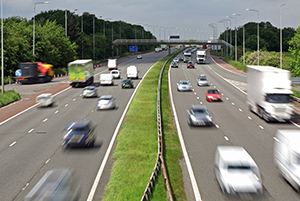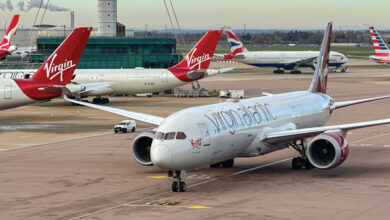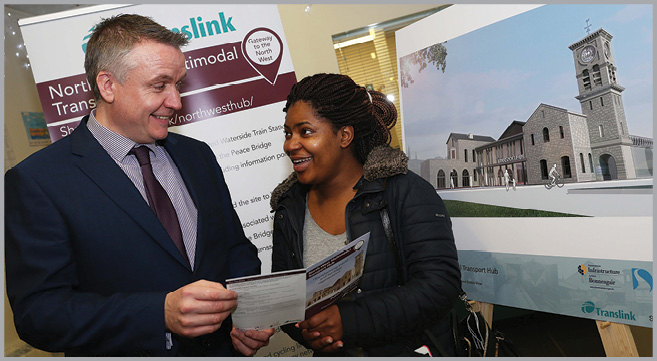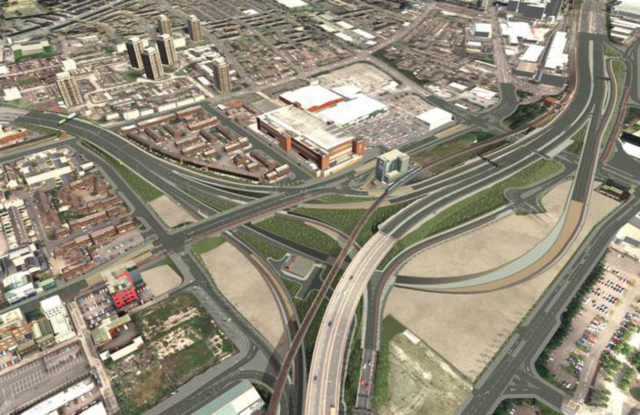A smarter future for motorways
 Following the publication of a study commissioned by TransportNI to assess the feasibility of creating additional capacity on Northern Ireland’s motorways, Adam Morton reviews its findings.
Following the publication of a study commissioned by TransportNI to assess the feasibility of creating additional capacity on Northern Ireland’s motorways, Adam Morton reviews its findings.
We’ve all been there, stuck in traffic at the start or end of a busy day. There are few things worse than being stuck in a string of traffic that you could walk faster than and the problem of congestion is often found on roads in and out of Belfast at peak travel times.
In an attempt to ease this congestion and in light of work undertaken by the Highways’ Agency in England, TransportNI has a commissioned a study to assess the impact that allowing vehicles to use the hard shoulders on motorways would have on traffic flow. The first of these ‘smart motorways’ was launched in England in 2006. It delivered additional motorway capacity at a lower capital cost than widening the road and provided a range of other safety and environmental benefits.
Need for additional capacity
In order to assess the need for additional motorway capacity to cater for peak-time travel, demand was assessed by analysing the capacity of the motorway network currently serving Belfast along with traffic census data and traffic growth predictions. An assessment was also undertaken to establish the motorway provision required to serve current public transport needs. This analysis, assumed each bus removes 40 private car journeys from the motorway. The M3 was not included in the analysis because the hard shoulder does not run consistently along that motorway and some sections of its hard shoulder are narrower than others.
The results of this analysis found:
• Smart motorway schemes on the M1 between Stockman’s Lane (J2) and Blaris (J8) and on the M2 between York Street (J1a) and Sandyknowes (J4) should be evaluated further;
• The same sections of motorway are also key routes for public transport services travelling to and from Belfast. Public transport services remove a significant number of private car journeys from the motorway network (11-19 per cent) although they represent only a small proportion of total traffic (0.6 per cent);
• Smart motorway schemes must make provisions for public transport services. A scheme developed to provide sufficient capacity for all traffic will also cater for buses and freight transport but complimentary measures e.g. dedicated slip-road exit lanes may be necessary additions.
Proposed schemes
With regard to the immediate need for additional capacity, three potential schemes were identified;
• M1 smart motorway – Stockman’s Lane (J2) to Blaris (J8) (for all traffic/both carriageways);
• M2 smart motorway – York Street (J1a) to Sandyknowes (J4) (for all traffic/both carriageways).
Another scheme on the M2, a bus lane from Greencastle (J2) to Duncrue Street (J1b) for southbound travel only, was identified as an interim and standalone scheme which could be implemented ahead of the M2 smart motorway scheme between York Street (J1a) and Sandyknowes (J4). There is also the potential for the scheme to form part of the temporary traffic management arrangements for the construction of the proposed York Street interchange with the existing M1 busways operating in a similar manner prior to the implementation of the M1 smart motorway.
The study acknowledged that the smart motorway scheme was initially developed by the Highways’ Agency on the basis of part-time hard shoulder use at peak times in line with their implementation guidelines. The scheme was re-appraised in 2012 following its conversion to full-time use. The appraisal by the Highways’ Agency found that the new approach offered the following additional benefits:
• There is no operational burden or technology equipment specifically associated with opening and closing the hard shoulder, resulting in capital and operational cost savings;
• Driver uncertainty as to whether the hard shoulder is open or closed is removed and accordingly, the misuse of closed hard shoulders will not be a problem;
• The proposed road layout provides consistency with the rest of the motorway network and does not, like dynamic hard shoulder use, rely upon signs to advise drivers what lanes can and can’t be used.
Benefits
Preliminary traffic modelling used in the study showed that the provision of additional motorway capacity generated through the proposed smart motorway schemes will generate increased throughput at peak times. As this was a high level study, designed to investigate the feasibility of implementing the schemes, the cost benefit analysis software COBA was used to evaluate the economic performance of the scheme.
COBA focuses on each link of the proposed development separately identifying the main benefits in terms of time savings and the value of reduced accidents. These benefits are then compared against costs of construction and maintenance.
The estimated benefit to cost ratio (BCR) for two of these schemes, the M1 smart motorway between J2 and J8 and the M2 smart motorway between J1a and J4, showed the schemes would be cost effective. However, doubts were raised about the economic benefit of the M2 smart motorway bus lane scheme from J2 to J1b although its poor result was blamed on the lack of a detailed traffic model.
Ultimately, the study found that if TransportNI was to take the smart motorway schemes forward they would deliver significant economic benefits along with other typical safety and environmental benefits.
M1 smart motorway – Stockman’s Lane (J2) – Blaris (J8)
• Permanent conversion of hard shoulders to running lanes on both carriageways
• 12.2km
• Cost estimate £35-£41 million (Q3 2011)
• Excellent economic returns
• Benefits for all road user types
• Reduced congestion to beyond 2016
• Improved journey time reliability to beyond 2026
• Deliverable within existing highway boundary and in shorter time than widening
• Safety improvements for workers and predicted users
• >60 per cent reduction in cost compared to other measures i.e. widening
M1 smart motorway – Stockman’s Lane (J2) – Blaris (J8)
• Combination of variable mandatory speed limits and permanent conversion of hard shoulder on both carriageways
• 10km
• Cost estimate £24-£28 million (Q3 2011)
• Positive economic returns
• Benefit to all road user types
• Reduced congestion beyond 2026
• Improved journey time reliability beyond 2026
• Deliverable within existing highway boundary
• Deliverable in less time than widening
• Safety improvement for workers and road users
• Circa 70 per cent reduction in cost compared to other measures i.e. widening
M2 smart motorway/bus lane – Greencastle (J2) – Duncrue Street (J1b)
• Hard should bus lane (South bound only)
• 4.4km
• Cost estimate £2-£2.5 million (Q3 2011)
• Significant journey time improvements for buses
• Improved bus journey reliability
• Reduced bus vehicle emissions
• Deliverable within existing highway boundary
• Assists public transport during major disruption for York Street interchange.





